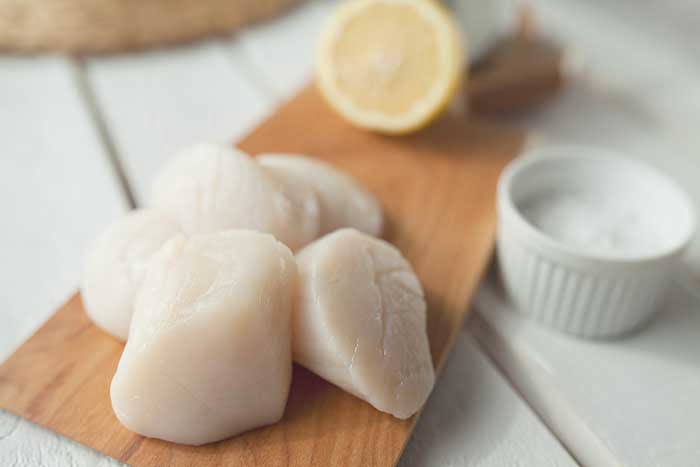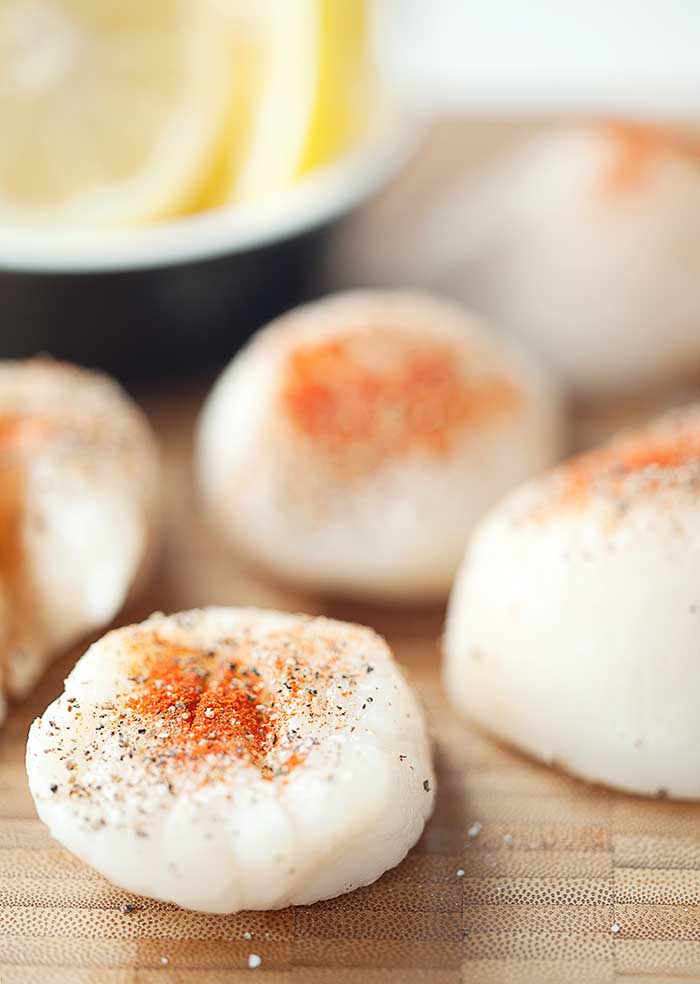Fresh scallops are the perfect seafood dish. You can grill, sauté, or pan-sear them with different but equally delicious results. Learn how to find and cook fresh scallops every time with our seafood guide.

Scallops are delicious seafood even for those who don’t love fish, but many people resign themselves to only eating them in restaurants. To the average home cook, cooking scallops is a daunting process with plenty of room for error.
However, it doesn’t have to be that way. Once you know a little about scallops and how to cook them, you can make restaurant-worthy seafood meals at home with very little trouble.
Here is a guide to everything that you need to know about buying, preparing, and enjoying scallops, whenever you want them.
What Are Scallops?

Scallops are a type of bivalve mollusk. Bivalve mollusks are seafood species that have two separate shells held together by a muscle. If you think of seafood or seashells, for example in The Little Mermaid, chances are, you’ll think of this type of shell. Oysters and mussels are other types of bivalve mollusks.
Scallops are also closely related to octopuses and snails, which are other types of mollusks. The mollusk family contains lots of delicious seafood favorites that are not technically fish but still live in the water.
While the term “scallop” can refer to the whole animal, we only eat a small part of the scallop. The white, round flesh you find at restaurants is the scallop’s adductor muscle, which is the part that holds the shell together and helps the shellfish move through the water.
Scallops are fascinating animals to study. They can be up to nine inches wide and swim fast compared to other shellfish. They also have a ring of eyes popping out of the edge of their shell—sometimes up to 200 of them!
Taste

There is a reason why scallops are nicknamed ‘the candy of the sea’. They are prized by consumers and chefs for their delicate, mild taste. While other seafood often overpowers your taste buds with its strong salty flavors, scallops are soft and almost sweet by comparison. Even people who normally don’t like seafood will make an exception for scallops.
Scallops have a versatile texture that makes them an asset for chefs and diners. They have a soft, buttery texture, almost like lobster, another prized seafood dish. This texture is why they are the centerpiece of dishes such as seafood scampi and pan-seared scallops.
Types of Scallop
Once they wind up on a plate, all scallops look the same. However, there are a few different types of scallops that you should know before you go shopping.
Sea
Sea scallops are the most common variety of the delicious mollusck. Found in the deep waters of the Atlantic Ocean, they are about two inches in diameter and have a fluted shell that has a red-pink color.
If you’ve had scallops in restaurants or bought them at the supermarket, chances are that they’ve been sea scallops. They have the delicate, sweet taste that seafood fanatics love. They are also one of the most sustainable choices for seafood consumption because they are not in danger of overharvesting.
Bay
Bay scallops are a seafood species that is almost entirely wild. They are found along the East Coast of the United States and migrate seasonally. Due to these migration patterns, they are only available seasonally from October to March when they return to the fisheries that make up their home.
Bay varieties are much smaller than sea scallops and often more expensive due to their rarity. However, their taste and texture are superior. They are sweeter and more tender than the sea variety, which tend to veer on the chewy side.
Calico
Finally, the third most common variety of the North American mollusk is the calico scallop. They are found in the Gulf of Mexico and other waters along the Southeastern United States coast. They are a seasonal variety, just like bay scallops, and are enjoyed between December and May.
Calico scallops are prized for their shells, which form intricate, tightly-sealed patterns. However, they are more difficult to access than the other two because the shell is hard to pry apart. They are often sold as replacements for bay scallops but are not as sweet.
Sea scallops are the most common variety that you will find in your supermarket. If you’re lucky, you may get a chance to sample one of the other two.
How to Choose Fresh Scallops

You can usually get fresh scallops at a fish market or even a high-end supermarket. Before you buy your scallops, you’ll want to make sure that you’re getting the best product.
You can tell if scallops are fresh by looking at them. They should look firm and plump with a pink or orange hue on top of their base white color. Pure white scallops are a sign that something is wrong with the scallops, so be sure that there is a hint of another color.
Before buying scallops, ask the fishmonger for dry scallops. Wet scallops have been treated with an STP solution to preserve them on their way to the market, but this detracts from the scallop’s natural flavor. If you have to buy wet scallops, be sure to pat them dry to get as much of the solution out as possible before cooking.
If the scallops have a feathery white pattern on their surface or darkened edges, that is a sign that they are not fresh. Before buying them, smell them. They should smell a little briny, like the sea, but not pungent, like ammonia or iodine. If the scallops are too pungent, that is a sign that they’ve begun to go bad.
If you cannot get fresh scallops, frozen scallops are a good substitute. Just be sure to get ones that have been frozen for at least a day and accept that the taste will not be as good as the fresh variety.
How to Cook Scallops
Scallops are lovely, versatile mollusks that do not need a lot of fuss to taste delicious. Here are a few suggestions for cooking them.
Pan-Searing
Pan-searing your scallops is easy and preserves their delicate flavor. To pan-sear your scallops, first prepare them. That means either taking them out of their shell if you’ve bought them fresh or thawing your frozen scallops.
Then, add a neutral oil to a skillet and wait for it to heat up. Once the oil is sizzling, add your scallops, giving them enough room to cook. Flip them after two minutes and repeat the process on the other side.
Finally, create a sauce to go with your pan-seared scallops. Melt unsalted butter then add seasonings of your choice, such as garlic, lemon juice, salt, or pepper. Coating the scallops in this simple sauce will only enhance their flavor.

Grilling
Grilling scallops is an excellent choice, particularly for the summer. Prepare the grill by brushing it with oil, and prepare the scallops by patting them dry and putting them onto skewers. You can even create a marinade of your choice, for example using lemon juice, garlic, and seasonings. You will need to be careful with the scallops because if you leave them on for too long they will get damaged, but grilling is a great way to maximize their flavor.
Why Are My Scallops Chewy?
Chewy scallops are the bane of many home chef’s existences. Instead of the tender, falling-apart texture you want, you may find yourself with tough scallops that work your jaw muscles.
The most common culprit is cooking time. Overcooking the scallops damages the muscle and ruins the texture. Scallops are very delicate and even a minute of excess heat can ruin the dish.
There is no way to salvage scallops once they become chewy, but you can prevent this problem from happening in the first place by paying close attention while cooking. Only cook the scallops for a few minutes on each side and don’t step away from the heat while they’re cooking. If you’re worried about them cooking all the way through, put them on at a higher heat. A higher temperature is better for scallops as it sears in the flavor without ruining the texture.
Leftovers
No one likes to see seafood go to waste, and scallops are no different. Sure, nothing beats them fresh from the pan or grill, but there are some beautifully inventive ways to use leftover scallops. You can throw them on top of a bed of lettuce for a simple seafood salad, but try these ideas for a bit more creativity:
- Bacon-Wrapped Scallops
- Lemon Garlic Seafood Linguini
- Po’boy Sandwich
- Indonesian Curry

Seared Scallops
Ingredients
- 1 lb sea scallops washed and side muscle removed
- kosher salt
- ground black pepper
- 1 tbsp extra-virgin olive oil
- 2 tbsp unsalted butter at room temperature
- 1 clove garlic minced
Instructions
- Heat oil in skillet over medium-high heat
- Pat scallops dry with paper towel and season with salt and black pepper
- When oil is hot, add scallops. Sear until golden brown, about 3 minutes.
- Turn scallops and cook on other side
- Add butter and garlic, continuously spooning over scallops until golden brown and cooked, about 3 minutes
- Remove from heat and serve immediately



